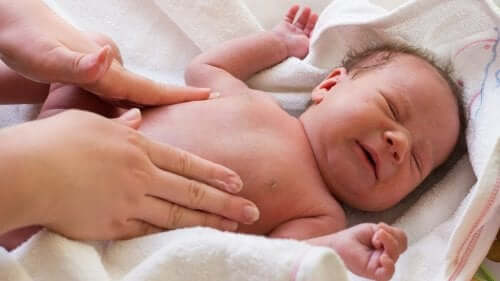Kusi Wawa Method to Soothe Baby Colic

Colic is a common problem that causes a lot of discomfort in babies. The Kusi Wawa method was born due to the fact that there was no quick way to relieve it. We’ll tell you all about it below.
The Kusi Wawa method is a technique that, combined with Dr. Harvey Karp’s method to treat colic and the application of heat to the abdominal area, has been the solution for many mothers.
What’s the Kusi Wawa method?
This treatment was created by Meritxell Vinyas, who despaired when her baby daughter suffered from bothersome colic and was unable to help her. As a result, she combined the theory Dr. Harvey Karp exposed in his book The Happiest Baby on the Block with the application of heat in her baby’s abdominal area. With that, she managed to calm her down in no time.
In an interview, Meritxell Vinyas explained that her daughter was born in the United States, where she discovered Harvey Karp’s theory. However, she ended up applying the method for the first time during a trip to Peru, where she finally named it.
Kusi Wawa is a Quechua term that means “the happiness of receiving a newborn in the family.”

What’s the Kusi Wawa Method?
The Kusi Wawa method consists of three different products:
- Wawa Wear. It’s the first thing that you put on your baby. It’s a 100% organic cotton pajama with a device that guides parents to set the Wawa Band in the correct position.
- Wawa Band. It’s a cotton band that’s placed over the baby’s tummy to apply heat. It also includes a cushion composed of seeds and herbs that uses thermotherapy and aromatherapy.
- Wawa Wrap. Also made of cotton; all you have to do is wrap it around your baby.
How to apply the Kusi Wawa Method
Although this method is quite simple, each of the products requires a series of steps. If you don’t have the Wawa Wear, you can use your baby’s usual pajamas.
These are the instructions to follow to apply the technique. You can also see them in this video:
- Button the Wawa Band around the baby’s waist to the Wawa Wear. Close it with the Velcro over your baby’s belly.
- Remove the thermic cushion and heat it in the microwave for about 20 to 25 seconds, preferably in a 800-watt microwave.
- Before placing the cushion in the pocket of the Wawa Band, make sure it isn’t too hot. Heat helps regulate intestinal transit and aromatherapy relaxes the baby.
- Begin applying the 5 S’s. Start by “swaddling” your baby to the Wawa Wrap. This makes your baby feel safe and soothes him.
- Then, put your baby on his side or stomach. After that, move on to “shush”, which means you need to calm your little one with a constant sound.
- The fourth step is “sway”, which is gently rocking the baby while you continue performing the above actions.
- Finally, apply “suck”, which is giving your baby a pacifier to help soothe him.
“Heat effectively acts as a pain reliever, and also helps to expel gases and feces.”

A recommended method
As confirmed by the official website of the Kusi Wawa method, this technique has been widely endorsed by the International Association of Infant Massage (AEMI) (Asociación Española de Masaje Infantil). They even began to use it in addition to massages to relieve gases and colic in babies.
In addition, as they highlight in their website, other important entities such as the Catalan Association of Pediatric Nursing (ACIP) and experts in the field such as Amelia Hunter, certified child sleep consultant, have endorsed the method.
Every baby is different, meaning some techniques might work better on your baby than others. Thus, you should switch things up to soothe your baby.
For example, you can try making different sounds or swaying your baby more gently. Ultimately, the most important thing is to finally decide on the techniques that soothe your baby the most.
Colic is a common problem that causes a lot of discomfort in babies. The Kusi Wawa method was born due to the fact that there was no quick way to relieve it. We’ll tell you all about it below.
The Kusi Wawa method is a technique that, combined with Dr. Harvey Karp’s method to treat colic and the application of heat to the abdominal area, has been the solution for many mothers.
What’s the Kusi Wawa method?
This treatment was created by Meritxell Vinyas, who despaired when her baby daughter suffered from bothersome colic and was unable to help her. As a result, she combined the theory Dr. Harvey Karp exposed in his book The Happiest Baby on the Block with the application of heat in her baby’s abdominal area. With that, she managed to calm her down in no time.
In an interview, Meritxell Vinyas explained that her daughter was born in the United States, where she discovered Harvey Karp’s theory. However, she ended up applying the method for the first time during a trip to Peru, where she finally named it.
Kusi Wawa is a Quechua term that means “the happiness of receiving a newborn in the family.”

What’s the Kusi Wawa Method?
The Kusi Wawa method consists of three different products:
- Wawa Wear. It’s the first thing that you put on your baby. It’s a 100% organic cotton pajama with a device that guides parents to set the Wawa Band in the correct position.
- Wawa Band. It’s a cotton band that’s placed over the baby’s tummy to apply heat. It also includes a cushion composed of seeds and herbs that uses thermotherapy and aromatherapy.
- Wawa Wrap. Also made of cotton; all you have to do is wrap it around your baby.
How to apply the Kusi Wawa Method
Although this method is quite simple, each of the products requires a series of steps. If you don’t have the Wawa Wear, you can use your baby’s usual pajamas.
These are the instructions to follow to apply the technique. You can also see them in this video:
- Button the Wawa Band around the baby’s waist to the Wawa Wear. Close it with the Velcro over your baby’s belly.
- Remove the thermic cushion and heat it in the microwave for about 20 to 25 seconds, preferably in a 800-watt microwave.
- Before placing the cushion in the pocket of the Wawa Band, make sure it isn’t too hot. Heat helps regulate intestinal transit and aromatherapy relaxes the baby.
- Begin applying the 5 S’s. Start by “swaddling” your baby to the Wawa Wrap. This makes your baby feel safe and soothes him.
- Then, put your baby on his side or stomach. After that, move on to “shush”, which means you need to calm your little one with a constant sound.
- The fourth step is “sway”, which is gently rocking the baby while you continue performing the above actions.
- Finally, apply “suck”, which is giving your baby a pacifier to help soothe him.
“Heat effectively acts as a pain reliever, and also helps to expel gases and feces.”

A recommended method
As confirmed by the official website of the Kusi Wawa method, this technique has been widely endorsed by the International Association of Infant Massage (AEMI) (Asociación Española de Masaje Infantil). They even began to use it in addition to massages to relieve gases and colic in babies.
In addition, as they highlight in their website, other important entities such as the Catalan Association of Pediatric Nursing (ACIP) and experts in the field such as Amelia Hunter, certified child sleep consultant, have endorsed the method.
Every baby is different, meaning some techniques might work better on your baby than others. Thus, you should switch things up to soothe your baby.
For example, you can try making different sounds or swaying your baby more gently. Ultimately, the most important thing is to finally decide on the techniques that soothe your baby the most.
This text is provided for informational purposes only and does not replace consultation with a professional. If in doubt, consult your specialist.








